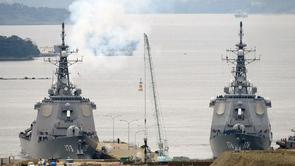 Japanese Maritime Self-Defense Force's Aegis guided-missile destroyers, Chokai and Kongo, leave their base in Sasebo, Nagasaki Prefecture for the Sea of Japan on March 28, 2009. (JIJI PRESS / AFP)
Japanese Maritime Self-Defense Force's Aegis guided-missile destroyers, Chokai and Kongo, leave their base in Sasebo, Nagasaki Prefecture for the Sea of Japan on March 28, 2009. (JIJI PRESS / AFP)
TOKYO - Japan’s decision to scrap two Aegis Ashore ballistic missile defense systems means it must find other ways to defend a 3,000-kilometre archipelago along Asia’s eastern edge.
Japan’s Aegis Ashore contracts are worth around US$1.7 billion, with more than US$100 million already spent. Over 30 years, the defense ministry estimated the budget at around US$4 billion, not including missile tests that sources last year said could cost at least US$500 million
Some policy makers want Japan to acquire the capability to attack enemy missiles before they are launched.
‘IMPOSSIBLE’ PROBLEM
In a surprise decision, defense minister Taro Kono recently halted the 2025 deployment of Aegis Ashore because booster rockets used to accelerate SM-3 Block IIA interceptor missiles might fall on communities in northern Akita and southern Yamaguchi prefectures.
ALSO READ: Japan scraps plan to deploy two Aegis Ashore missile systems
That problem, according to military experts, has been known since Japan picked Aegis Ashore in 2018. The interceptor was developed for use at sea, where debris would fall harmlessly.
“From the beginning, the Japanese government’s story was impossible. I was a missile shooter, I knew how difficult it would be to control the fall of burned-out boosters,” former Maritime Self Defense Force admiral Yoji Koda, who commanded Japan’s naval fleet from 2007 to 2008, told Reuters.
The expense of Aegis Ashore project also affected Kono’s decision.
Japan’s Aegis Ashore contracts are worth around US$1.7 billion, with more than US$100 million already spent. Over 30 years, the defense ministry estimated the budget at around US$4 billion, not including missile tests that sources last year said could cost at least US$500 million.
ALTERNATIVES
For now, Japan will rely on destroyers with older Aegis radars that guide less-powerful SM-3 interceptors, which can hit enemy missiles in space and can be upgraded to tackle other threats. Japan also has PAC-3 Patriot missile batteries, which can shoot at plunging warheads in their last seconds before impact.
ALSO READ: Japan gets its 8th defense budget hike, hits US$48.56b
Japan is increasing the range and accuracy of its Patriots and by next year will have eight Aegis destroyers. Crewing ships with about 300 sailors each, however, strains naval resources as the country struggles to find recruits.
“Having two or three Aegis ships in the Sea of Japan is a waste of assets. I think Aegis Ashore is a good option,” said Noboru Yamaguchi, a Sasakawa Peace Foundation adviser and former Ground Self Defense Force general.
Japan could add another layer of defense, such as the US Terminal High Altitude Area Defense (THAAD) missiles, which aims at warheads between the capabilities of SM-3s and Patriots. Their mobile launchers are easier to deploy than fixed Aegis sites, but could still face opposition from residents because several missile batteries, which use powerful radars, would be needed to cover Japan’s big cities.
STRIKE OPTION
Japan’s National Security Council, led by Prime Minister Shinzo Abe, will this summer consider whether to buy weapons for attacking missile sites before a launch.
A council made up senior ruling Liberal Democratic Party lawmakers, including four former defense ministers, will also weigh the idea. Itsunori Onodera, who approved the Aegis Ashore purchase when he was defense chief, is leading the discussion.
READ MORE: Japan to spend more on defense, refit 1st aircraft carrier
Such an option is attractive because it is easier to hit missiles sitting on launch pads than to attack them in flight.
Onodera argues that attacking missile sites is the modern equivalent of downing enemy bombers, putting it in line with Japan’s war-renouncing constitution, which allows for self defense.
In 2017 Onodera approved the purchase of air-launched cruise missiles with a range of up to 1,000 kilometres that can be fired from F-35 stealth fighters or F-15 attack jets, making them able to strike targets in North Korea from the Sea of Japan.
SNAGS
Those cruise missiles are not effective without satellites or other means of providing precise targeting information, and of telling whether an attack is imminent. Japan has launched surveillance satellites on its H-2A rocket, most recently in one in February, but those are not designed for strike-targeting.
If Japan musters a first-strike capability, it could face opposition from China, Russia and even South Korea.
READ MORE: Japan seeks record military budget to boost missile defenses
That may not stop Japan, but resistance from the United States could. Under their military alliance, Japan provides a defensive shield that protects US forces. Past US administrations have opposed an independent Japanese strike capability.
Constitutional considerations could also curtail the scope of strikes. Japan’s US-authored constitution renounces its right to wage war.
Any first-strike doctrine would have to be carefully defined before it is even considered by the NCS, Kono said in Tokyo last month.


